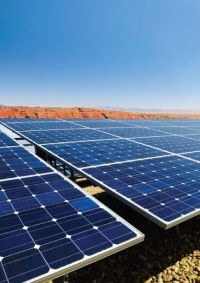Dixie Solar Farm
I read last January this interesting story in the Deseret News about a Dixie solar farm. It is not quite ready for the masses but should appeal to early adopters and the environmentally sensitive. With the tax credits and the future cost of electricity sure to rise I would be tempted to buy into a similar project if it was offered locally.
More Power To You
The city of St. George Energy Services Department and Dixie Escalante Electric have built a large solar photo-voltaic facility, allowing residents to purchase solar power to supplement the energy supplied by more conventional means. This takes advantage of the 310 days a year of sunlight, increases the use of renewable sources, provides local power, and increases sustainability and energy security for the growing community.
Own Your Own Power Plant
Residents of St. George can now invest their money locally, lower their carbon footprint, and control a portion of their power supply. They can purchase a whole or half SunSmart solar unit of 1 kilowatt installed solar PV capacity and own it for 19 years. Thereafter the panels will be replaced or repaired with the purchaser having the choice to pay the cost. The economies of scale make SunSmart an affordable, maintenance-free way to take advantage of solar power. The power generated by the SunSmart solar farm will be sent to one of the city’s substations and then the power is transported throughout the community via existing distribution circuits.
Solar Credits
Those that own one of the 466 black and gray solar panel units pay no more fees after the initial $6,000 and receive a credit on their monthly power bill. One St. George resident reported in December last year a solar credit of $3.90. A small amount but as electric rates increase in the future, the value of the energy credit will also increase. Each unit is priced to cover the cost of the equipment and installation. The city is not making any money off of this project; all of the savings go to the purchaser. By having a solar farm of this size the purchaser benefits from the economies of scale. Residents have a limit of four units or eight half units that they can buy. One unit will generate about 140 kWh per month and has a guaranteed minimum output of 800 kW hours a year. When I checked today the solar farm had produced 466 kW hours of power. Not bad for the dead of winter. Check to see how much power was produced today.
Tax Credits
There is a one-time Utah income tax credit of 25% of the purchase price up to $2,000 but no Federal tax credit. The person receiving the tax credit must live in St. George and they must also be receiving the credit of energy. The city worked with the state legislature to make it possible for homeowners to receive state tax credits for renewable energy investment not on the homeowner’s own property. St. George is the only city that currently offers a program that takes advantage of this tax credit for an off-site system. In a refreshing move by the city, it has not forced anyone to pay for the project if they did not want to be a part of it.
Environmental Impact
Every kilowatt hour of solar electricity produced offsets 1.8 grams of nitrous oxides, 0.9 grams of sulfur dioxide, and 986 grams of carbon dioxide, if the kWh was produced at an average Utah coal-fired plant. The offset in carbon dioxide is equivalent to driving 2.2 fewer miles.
The Guv’nor Likes Solar
At the SunSmart solar facility opening ceremony Governor Huntsman cranks out the puns with the words charge and potential:
Utah is poised to lead the charge in energy efficiency, renewable and alternative energy development with new and innovative technologies. Projects like St. George’s SunSmart are the perfect example of our state’s great potential being put into action.
During the late 20th century, Utah had already begun its journey on renewable energy with the development of hydroelectric plants in canyons adjacent to population centers. At present, renewable resources account for about 923 gigawatts of electric generation capacity in the state. This includes solar, wind, biomass, geothermal, and hydro production. The state has supported the growth of renewable energy by funding such projects including the installation of solar panels on the visitor’s center at Goblin Valley State Park, the headquarters for the Utah Department of Natural Resources, and Yuba State Park. The state continues to encourage renewable energy through direct purchase, policy, and incentives.
I agree with the Governor. We have the land, the entrepreneurs, the technology, and plenty of sunlight. With the current move to solar Utah’s star is indeed shining.


